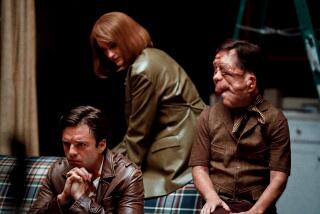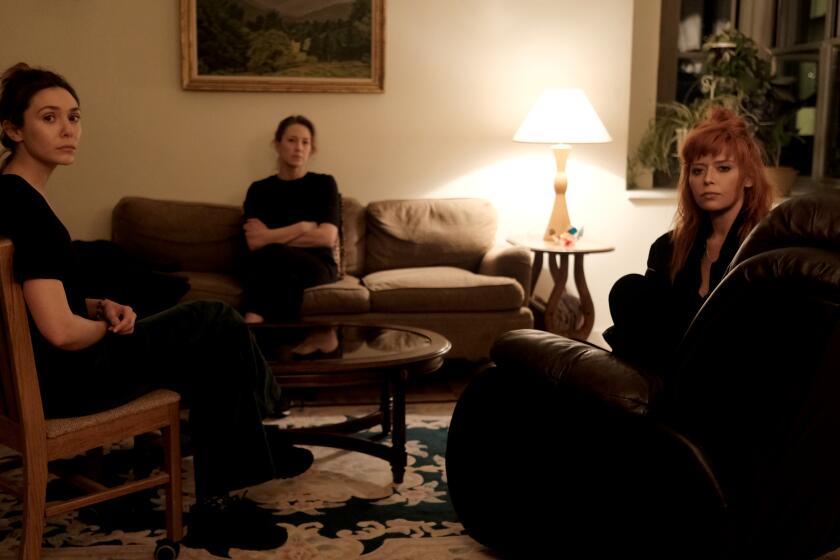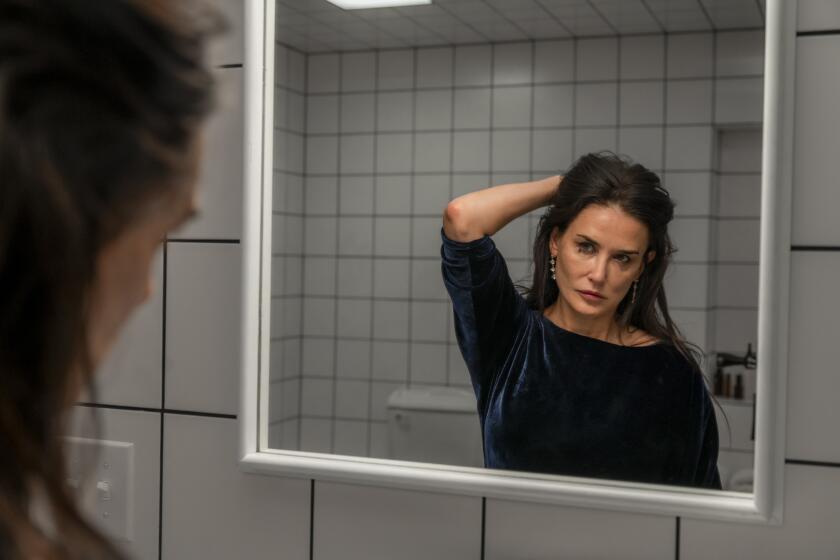Michael Fassbender’s big head in ‘Frank,’ a counterpoint in TMZ era
Modern movie stardom is dependent on many things, but perhaps none more so than well-known, good-looking faces appearing in new films.
So what would make a high-profile actor decide to spend most of a movie wearing a cartoon face that renders him unrecognizable? And apart from a sense of masochistic mischief, what would prompt someone to make a movie with just that conceit?
It’s a question that will be running through your head with Magnolia Films’ release Friday of a new indie dramedy “Frank,” directed by the Irish filmmaker Lenny Abrahamson and starring Michael Fassbender.
“Head” is a key word, since Fassbender — of course famous as Magneto in the “X-Men” series and in rigorous dramas such as “12 Years a Slave” — spends most of the film in a giant one, a fully concealing apparatus that looks like a cross between a Lego mini figure and one of those inflatable replicas of Edvard Munch’s “The Scream.”
If you see the movie, you may find yourself furtively checking your phone halfway through wondering if you misread Fassbender’s billing — or, perhaps, calming a zealous spouse who wants to rush back to the ticket window asking for a refund. But it’s indeed Fassbender under there, speaking in an American accent, as a character inspired by Frank Sidebottom, a real-life musician who, in the tradition of the Residents and Daft Punk, was almost never seen performing without the disguise.
“Frank” actually takes this character one step further, since the Daft Punk duo presumably takes its masks off in private. Fassbender’s Frank keeps it on all the time--even, as another of his bandmates matter of factly notes, when showering and brushing his teeth.
Oh, and technically he’s not Frank Sidebottom but a character named Frank who’s inspired by him. In fact, Frank Sidebottom wasn’t even Frank Sidebottom — he was a character played on-stage by the musician Chris Sievey in late-1980s England.(Sievey died in 2010.) The journalist Jon Ronson, at the time an aspiring rock keyboardist, was recruited rather spontaneously into Sievey’s band, and he co-wrote this script in part based on that experience.
There are, then, layers of irony. Figuratively. But also literally.
As it follows the journey of the eccentric-but-vulnerable masked man via Jon (Domhnall Gleeson), “Frank” is a kind of indie-music Pilgrim’s Progress that’s also a sideways comment on modern celebrity. When it screened at the Sundance Film Festival this year the movie garnered hard-core fans taken by its abject weirdness and occasional self-consciousness, as well as plenty of skeptics put off by, well, its abject weirdness and occasional self-consciousness.
“I remember reading the script and thinking, ‘What the … is this?’” Fassbender said as he nursed a smoothie at a downtown hotel. “It’s just bizarre and original and I thought, ‘I gotta do this.’”
Abrahamson said he had in mind a commentary on the increasingly entangled world of creativity and celebrity, and the promotional realm where the two meet.
“Modern entertainment can encourage the public’s fetishization of the personality over the work,” Abrahamson said. “And that leads to a split between the person who makes the work and the showman who has to go out there and sell it. It’s a real fracture, and Frank is basically saying, ‘What happens if you don’t let that take place?’”
In other words, in an age of social-media oversharing, “Frank” questions the whole machine, the one that both builds up and tears down stars, The film asks if we’ve fully contemplated a world where an appetite for celebrity has overwhelmed our sense of mystery. It wonders if in this TMZ era, ambiguity and secrecy may be the most watchable spectacle of all.
And it does so by casting Fassbender — who, as Abrahamson notes, “is not just a famous actor, but someone whose face is talked about more than other famous actors.”
Of course, the irony is that getting a movie like this funded (its $2 million budget was bankrolled largely by the U.K.’s Film4 and British Film Institute) relies precisely on the star power the film partly debunks. Abrahamson said that financiers were aware from the outset that they would be covering up their best-known asset and made their peace with it early on.
Though he couldn’t really see out of the mask, Fassbender said acting in the film wasn’t a challenge. In fact, he noted, “It was quite liberating. It’s like you put on fancy dress or a Halloween costume and you feel a little invincible.” Plus, he quipped, “If I didn’t want to go to work, I just sent in the double.”
Still, there’s a creative hurdle to clear when filmgoers can’t register any facial expression. At one point Frank narrates his reactions (“Underneath I’m giving you a welcoming smile” or “Lips pursed together, as if to say enough frivolity”), prompting a bandmate played by Maggie Gyllenhaal to ask him to knock it off.
All of this is not so much an affect, we learn, but Frank’s way of dealing with crippling self-doubt. (Fassbender said he chose to make the film in part because he was fascinated by a character “who has this anxiety about playing in public but the music seized him anyway.”) In fact, when the mask does eventually come off, the legend built up around Frank quickly crumbles.
The director sees this as a kind of “Wizard of Oz” moment, only with modern celebrity as the great facade to be unmasked. “At the end you don’t find the little guy behind the curtain but the A-list actor,” Abrahamson said.
Of course, as a viewer you’ll have known it was Michael Fassbender all along. In this age of celebrity press, there’s no keeping that kind of secret.
More to Read
Only good movies
Get the Indie Focus newsletter, Mark Olsen's weekly guide to the world of cinema.
You may occasionally receive promotional content from the Los Angeles Times.











